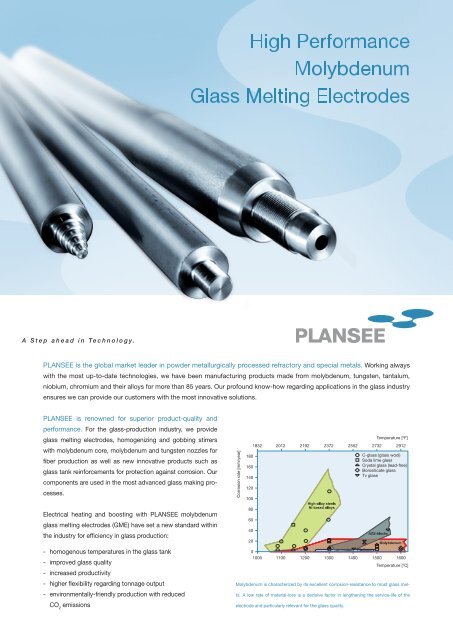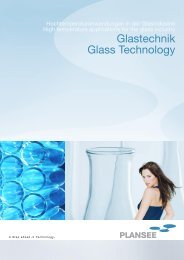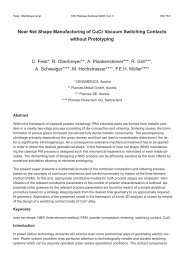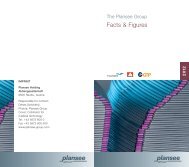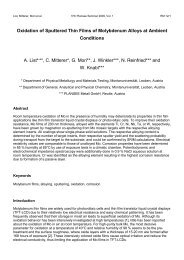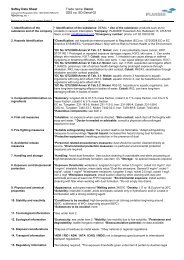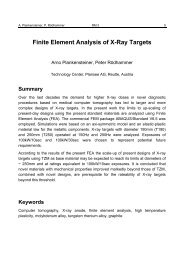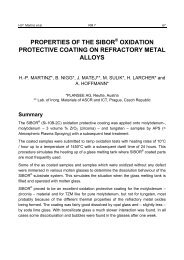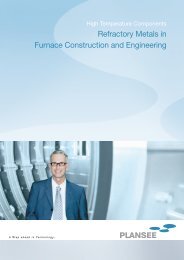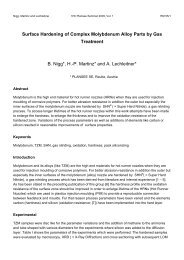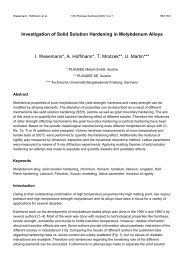Molybdenum glass melting electrodes
Molybdenum glass melting electrodes
Molybdenum glass melting electrodes
Create successful ePaper yourself
Turn your PDF publications into a flip-book with our unique Google optimized e-Paper software.
High Performance<br />
<strong>Molybdenum</strong><br />
Glass Melting Electrodes<br />
PLANSEE is the global market leader in powder metallurgically processed refractory and special metals. Working always<br />
with the most up-to-date technologies, we have been manufacturing products made from molybdenum, tungsten, tantalum,<br />
niobium, chromium and their alloys for more than 85 years. Our profound know-how regarding applications in the <strong>glass</strong> industry<br />
ensures we can provide our customers with the most innovative solutions.<br />
PLANSEE is renowned for superior product-quality and<br />
performance. For the <strong>glass</strong>-production industry, we provide<br />
<strong>glass</strong> <strong>melting</strong> <strong>electrodes</strong>, homogenizing and gobbing stirrers<br />
with molybdenum core, molybdenum and tungsten nozzles for<br />
fiber production as well as new innovative products such as<br />
<strong>glass</strong> tank reinforcements for protection against corrosion. Our<br />
components are used in the most advanced <strong>glass</strong> making processes.<br />
Electrical heating and boosting with PLANSEE molybdenum<br />
<strong>glass</strong> <strong>melting</strong> <strong>electrodes</strong> (GME) have set a new standard within<br />
the industry for efficiency in <strong>glass</strong> production:<br />
- homogenous temperatures in the <strong>glass</strong> tank<br />
- improved <strong>glass</strong> quality<br />
- increased productivity<br />
- higher flexibility regarding tonnage output<br />
- environmentally-friendly production with reduced<br />
CO emissions<br />
2<br />
Corrosion rate [mm/year]<br />
rate [mm/year]<br />
180<br />
160<br />
140<br />
120<br />
100<br />
80<br />
60<br />
40<br />
20<br />
0<br />
1000<br />
180<br />
160<br />
140<br />
1832<br />
2012<br />
1100<br />
2192<br />
1200<br />
2372<br />
1300<br />
2552<br />
1400<br />
Temperature [ºF]<br />
2732 2912<br />
C-<strong>glass</strong> (<strong>glass</strong> wool)<br />
Soda lime <strong>glass</strong><br />
Crystal <strong>glass</strong> (lead-free)<br />
Borosilicate <strong>glass</strong><br />
Tv <strong>glass</strong><br />
1500 1600<br />
Temperature [ºC]<br />
<strong>Molybdenum</strong> is characterized by its excellent corrosion-resistance to most <strong>glass</strong> mel-<br />
ts. A low rate of material-loss is a decisive factor in lengthening the service-life of the<br />
Temperature [ºF]<br />
electrode 1832 and particularly 2012 relevant 2192 for the <strong>glass</strong> 2372 quality. 2552 2732 2912<br />
C-<strong>glass</strong> (<strong>glass</strong> wool)<br />
Soda lime <strong>glass</strong><br />
Crystal <strong>glass</strong> (lead free)<br />
Borosilicate <strong>glass</strong><br />
Tv <strong>glass</strong>
2<br />
Higher performance in the <strong>glass</strong> tank: PLANSEE molybdenum<br />
Wherever operating temperatures and chemical requirements exceed the limits of conventional materials such as iron, copper,<br />
or nickel – molybdenum stands out with unique properties:<br />
- high material strength at high temperatures<br />
- good electrical conductivity<br />
- excellent corrosion-resistance against molten <strong>glass</strong><br />
Physical properties of molybdenum<br />
Testing temperature 20 °C / 68 °F 1000 °C / 1832 °F<br />
Melting point [ °C / °F ] 2620 / 4748<br />
Density [g /cm 3 ] 10.2 -<br />
Thermal conductivity [ W/mK ] 141 113<br />
Specifi c electrical resistance [ Ω mm 2 /m ] 0.056 0.315<br />
Av. specifi c heat (20 °C / 68 °F to temp.) [ J/ kg K ] 254 303<br />
Av. linear thermal expansion (20 °C / 68 °F to temp.) [ 1/ K ] 5.15 x 10 -6 5.84 x 10 -6<br />
Emissivity (ground surface) 0.06 0.16<br />
Vapour pressure [mbar] 2.5 x 10 -6 ( 1500 °C / 2732 °F )<br />
Young’s modulus [GPa] 320 270
Our contribution to efficient <strong>glass</strong> <strong>melting</strong><br />
Whether you are manufacturing with fully or partially electrically-heated <strong>glass</strong> tanks or using an electrical boosting system, PLANSEE<br />
offers the ideal <strong>glass</strong> <strong>melting</strong> <strong>electrodes</strong>. High-quality <strong>glass</strong> production requires top performance from the <strong>glass</strong> <strong>melting</strong> <strong>electrodes</strong>.<br />
Whether you opt for standard or for customized dimensions and design, PLANSEE products will always provide you with:<br />
- highest material purity<br />
- optimized creep strength<br />
- high corrosion-resistance<br />
- guaranteed oxidation protection thanks to SIBOR ® coating<br />
Highest material purity<br />
Our <strong>glass</strong> <strong>melting</strong> <strong>electrodes</strong> stand out by reason of their high purity. For molybdenum PLANSEE guarantees an overall purity of<br />
99.97 %. In most cases the degree of purity is even higher (99.99 %). Traces of impurities such as carbon, nickel, and iron can<br />
lead to bubble formation or discoloration of the <strong>glass</strong> melt. PLANSEE sets up the manufacturing process with pure molybdenum<br />
oxide, without any recycled scrap. By manufacturing entirely in-house – from the conversion of oxide into metallic molybdenum<br />
powder, to pressing, sintering, deformation and finishing – PLANSEE guarantees the highest quality available.<br />
Raw material<br />
(oxide)<br />
Reduction Metal Mixing /<br />
Pressing<br />
powder Alloying<br />
Schematic process for the production of molybdenum products<br />
Chemical specifi cation<br />
for molybdenum products<br />
Element<br />
Guaranteed<br />
analysis<br />
max. [ µg /g]<br />
Typical<br />
analysis<br />
max. [ µg /g]<br />
Ag 10 < 5<br />
Al 10 < 5<br />
As 5 1<br />
Ba 5 < 1<br />
C 30 15<br />
Ca 20 5<br />
Cd 50 < 2<br />
Co 20 3<br />
Cr 20 3<br />
Cu 20 5<br />
*) Metallic purity without tungsten<br />
Element<br />
Guaranteed<br />
analysis<br />
max. [ µg /g]<br />
Sintering<br />
Deformation<br />
Typical<br />
analysis<br />
max. [ µg /g]<br />
Fe 60 30<br />
H 10 3<br />
K 10 3<br />
Mg 10 < 5<br />
Mn 2 < 1<br />
N 5 < 2<br />
Na 10 < 2<br />
Nb 10 < 5<br />
Ni 10 5<br />
O 40 15<br />
- fast delivery from stock<br />
- reliable and certified quality inspection<br />
- customized finishing<br />
Heat<br />
treatment<br />
Element<br />
Machining<br />
Joining<br />
Coating<br />
Guaranteed<br />
analysis<br />
max. [ µg /g]<br />
Quality<br />
assurance<br />
Typical<br />
analysis<br />
max. [ µg /g]<br />
P 20 < 10<br />
Pb 10 3<br />
S 10 < 2<br />
Si 30 5<br />
Ta 20 < 10<br />
Ti 10 2<br />
W 250 100<br />
Zn 10 < 5<br />
Zr 10 < 2<br />
Mo min. 99.7 %* 99.99 %*<br />
3
4<br />
Optimized creep strength<br />
The coarse grain structure of PLANSEE<br />
<strong>electrodes</strong> results in higher creep-resistance.<br />
PLANSEE <strong>electrodes</strong> minimize<br />
any bending during operation,<br />
which leads to higher efficiency, less<br />
corrosion of the surroundings and less<br />
wear of the electrode. Moreover less<br />
bending minimizes the danger of any<br />
contact of the <strong>glass</strong> <strong>melting</strong> electrode<br />
and its holder. Coarse grain-structure for best creep-resistance Fine grain-structure with low creep-resistance<br />
High corrosion resistance<br />
PLANSEE operates the world’s largest hammer forging machine for refractory metals.<br />
With a force of more than 20 t /cm 2 the <strong>glass</strong> <strong>melting</strong> <strong>electrodes</strong> are forged to final<br />
dimensions with very tight dimensional and surface tolerances. Since no additional<br />
machining is required, this results in completely closed grain-boundaries and an<br />
extremely dense surface condition, which leads in turn to unrivalled corrosion-<br />
resistance.<br />
Fact Box<br />
Creep-resistance [MPa]<br />
Creep-strength of Mo with coarse grain-structure<br />
Creep-strength of Mo with fine grain-structure<br />
1000 1200 1400 1600<br />
Temperature [ºC]<br />
Creep-resistance of molybdenum with coarse grain-structure<br />
Hammer forging machine<br />
Competitor
Guaranteed oxidation-protection through SIBOR ® coating<br />
Above 400 °C / 752 °F molybdenum starts to react with air, forming MoO 3 , which sublimates at higher temperatures as yellow<br />
smoke. During the up-tempering of the <strong>glass</strong> tank the new PLANSEE SIBOR ® coating reliably protects the <strong>electrodes</strong> against any<br />
oxidation. SIBOR ® adheres inseparably to the molybdenum by building a diffusion zone on the molybdenum surface. SIBOR ®-<br />
coated <strong>electrodes</strong> or <strong>glass</strong> tank reinforcement can easily be installed in a new or rebuilt tank. For further applications of SIBOR ®<br />
coating please refer to our SIBOR ® brochure.<br />
Glass <strong>melting</strong> <strong>electrodes</strong> with SIBOR ® coating<br />
Micrograph of a cross-section of as-coated<br />
SIBOR ® , thickness 150 µm<br />
Fact Box<br />
SEM (BS-mode) of a heat-treated SIBOR ® coating;<br />
EDX: 1 - Si (molten SIBOR ® ); 2 - Si, 4 - Mo, (Si);<br />
3, 5 - Mo<br />
PLANSEE SIBOR ® coating.<br />
Guaranteed protection.<br />
- SIBOR ® guarantees protection during the up-tempering process<br />
- SIBOR ® simplifies the installation in the <strong>glass</strong> tank which eliminates<br />
potential danger for the operators<br />
- SIBOR ® opens up new possibilities of using plate or block <strong>electrodes</strong><br />
to heighten the performance of the <strong>glass</strong> tank<br />
- SIBOR ® -coated <strong>electrodes</strong> are easy to handle<br />
<strong>Molybdenum</strong> throat channel protection fully coated<br />
with SIBOR ®<br />
SIBOR ® -coated <strong>Molybdenum</strong> plate electrode<br />
SEM (BS-mode) cross-section of an oxidized SIBOR ® -<br />
coated Mo-sample (168 h in air at 1450°C). EDX: 1 - SiO2;<br />
2 - Mo, Si; 3 - Si, Mo; 4 - Mo, Si, B; 5 - Mo, (Si); 6 - Mo<br />
5
6<br />
Fast delivery from stock<br />
All standard dimensions of <strong>glass</strong> <strong>melting</strong> <strong>electrodes</strong> are available directly from stock via PLANSEE Express. The diameters from<br />
the list below are all delivered in our special smooth-forged surface-quality with stated straightness. Metric, tapered or customerspecific<br />
threadings are available in two to three weeks. The table below shows the recommended standardized metric and tapered<br />
threads for the respective electrode diameters in order to guarantee optimal mechanical and electrical properties when in use.<br />
Diameter<br />
[mm]<br />
Diameter<br />
[inch]<br />
Production<br />
lengths<br />
[mm]<br />
(tolerance:<br />
≤ 1000 = ± 5%<br />
> 1000 = ± 50mm)<br />
Standard dimensions and thread types for <strong>glass</strong> <strong>melting</strong> <strong>electrodes</strong><br />
Straightness<br />
per m<br />
[mm]<br />
Diameter<br />
tolerance<br />
(forged<br />
surface)<br />
Average<br />
weight<br />
[kg/m]<br />
Typical threads<br />
Cylindrical Tapered<br />
31.75 1.25 2000 < 2.0 ± 0.3 8.1 M22 x 1.5 M18 x 1.5 7 / 8 - 14 UNF<br />
48 3000 < 1.5 ± 0.3 18.5 M24 x 1.5 M22 x 1.5 7 / 8 - 14 UNF<br />
1 - 8 UNC<br />
3.00 T/ft.<br />
50.8 2 2000 < 1.0 + 0 / - 0.8 20.7 M27 x 3 M24 x 1.5 1¼ - 12 UNF 19 /16 - 8 UN<br />
3.00 T/ft.<br />
54 2000 < 1.0 ± 0.4 23.4 M36 x 3 M27 x 3 1¼ - 12 UNF<br />
60 2000 < 1.0 ± 0.4 28.8 M36 x 3 M27 x 3 1¼ - 12 UNF<br />
63.5 2.5 2000 < 1.0 ± 0.4 32.3 M36 x 3 1¼ - 12 UNF 19 /16 - 8 UN<br />
3.00 T/ft.<br />
70 2000 < 2.5 ± 1.0 39.3 M42 x 3 1½ - 12 UNF<br />
76.2 3 2000 < 2.5 ± 1.0 46.5 M42 x 3 1½ - 12 UNF<br />
80 2000 < 2.5 ± 1.0 51.3 M42 x 3 1½ - 12 UNF<br />
90 2000 < 2.5 ± 1.0 64.9 M58 x 3 2 ¼ - 8 UNF<br />
1 15 /16 - 8<br />
UN 3.00<br />
T/ft<br />
101.2 4 2000 < 2.5 ± 1.0 82.0 M58 x 3 2 ¼ - 8 UNF 2 3 /8 - 6 UN<br />
3.00 T/ft<br />
1 15 /16 - 8<br />
UN 3.00<br />
T/ft<br />
2 3 /8 - 6 UN<br />
3.00 T/ft<br />
3 - 6 UN<br />
3.00 T/ft<br />
Special thread dimensions according to our customers‘ specifications, as well as different length and diameter tolerances are<br />
available. Quotations and delivery times on request.
Reliable and certified quality inspection<br />
To guarantee top performance our inspection routines include chemical analysis and dimensional control of threading, diameter,<br />
straightness, and length. Additionally, each electrode is ultrasonically tested to detect even the smallest cracks and to minimize<br />
the risk of breaking.<br />
Our company is certified according to ISO 9001. Moreover, we are capable of carrying out chemical analyses as well as investigations<br />
of physical properties in our authorized and certified laboratories in accordance with customers’ requests.<br />
Customized finishing<br />
PLANSEE offers customer-specific threadings, cooling drills, and customized coatings such as NICROM ® , a steam-resistant<br />
inside coating to minimize steam boiling corrosion.<br />
Different electrode designs, such as block and plate <strong>electrodes</strong> in various dimensions, can be manufactured. These designs are<br />
available with or without SIBOR ® coating for oxidation-protection during up-tempering of the <strong>glass</strong> tank.<br />
Quality inspection for <strong>glass</strong> <strong>melting</strong> <strong>electrodes</strong>:<br />
Ultra-sonic testing Straightness Threading<br />
7
8<br />
Application Information<br />
Over the years, PLANSEE has gained considerable insight into factors critical for success in the <strong>glass</strong> industry. With profound<br />
application know-how we strengthen our customer’s competitiveness and improve performance levels. For the correct operation<br />
of molybdenum <strong>glass</strong> <strong>melting</strong> <strong>electrodes</strong> please take careful note of the following information.<br />
No lubricants in threadings<br />
Lubricants are not necessary for the connection of standard threads. If connected properly, the threads will not jam and the<br />
shoulders will fit precisely. Depending on their type and composition, lubricants can even cause problems. Organic lubricants<br />
burn at high temperatures and the carbon released in this process can diffuse into the molybdenum. For applications in the field<br />
of the <strong>glass</strong> industry only small amounts of carbon impurities are permissible, as carbon can cause CO and CO bubbles to form.<br />
2<br />
Furthermore, lubricants can have an insulating effect which hinders the flow of current.<br />
Connection via shoulder contact<br />
To ensure optimum flow of current, the <strong>glass</strong> <strong>melting</strong> <strong>electrodes</strong> have to be connected via shoulder contact. The shoulder and<br />
threading of the <strong>electrodes</strong> have to be free of any cracks, scratches and marks to ensure a tight contact. PLANSEE has adapted<br />
the design of tapered threads to guarantee tight contact as shown below:<br />
Standard tapered thread without shoulder contact. Tapered thread with shoulder contact for a <strong>glass</strong> <strong>melting</strong> electrode application
Threading recommendations<br />
Length and diameter of the threading have to be adapted<br />
on the diameter of the electrode. The threading has to absorb<br />
the bending strength of the electrode. General rule is<br />
that the diameter of the threading should be approximately<br />
20 mm less than the diameter of the electrode to ensure<br />
a large sufficient contact. The length and diameter of the<br />
threading should be approximately equal.<br />
Recommended PLANSEE standard threadings are.<br />
Thread<br />
Length of<br />
male thread<br />
A [mm]<br />
Recommended cylindrical thread design for <strong>glass</strong> <strong>melting</strong> <strong>electrodes</strong><br />
Metric threads UN threads<br />
Depth of<br />
female thread<br />
B [mm]<br />
Chamfer<br />
C [mm]<br />
Thread<br />
Length of<br />
male thread<br />
A [mm]<br />
Depth of<br />
female thread<br />
B [mm]<br />
M 18 x 1.5 20.5 22.5 1.5 7/8 - 14 UNF 25.5 27.5 2.0<br />
M 22 x 1.5 24.5 26.5 1.5 1 1/4 - 12 UNF 29.0 31.0 2.5<br />
M 24 x 1.5 26.5 28.5 1.5 1 1/2 - 12 UNF 34.0 36.0 2.5<br />
Chamfer<br />
C [mm]<br />
M 27 x 3 31.5 33.5 3.0 2 1/4 - 8 UNF 51.0 53.0 3.5<br />
M 36 x 3 33.5 35.5 3.0<br />
M 42 x 3 38.5 40.5 3.0<br />
M 58 x 3 51.0 53.0 3.0<br />
Regarding bending strength tapered threads are in general less favourable than metric threads.<br />
Turning of the electrode at regular intervals<br />
The flow of the <strong>glass</strong> around the <strong>electrodes</strong> leads to an ununiform wear, mainly this causes an elliptical cross section by erosion<br />
processes. This elliptical shape has much less creep-resistance than round shaped <strong>electrodes</strong> and the bending leads to a breaking<br />
of the electrode. This mechanism of becoming elliptical can be avoid by turning the electrode in regular intervals. To prevent<br />
the threads from becoming loose during turning process the <strong>electrodes</strong> have to be turned in a clockwise direction only.<br />
B<br />
D<br />
A<br />
C<br />
9
10<br />
Temperature [˚C]<br />
Application Information<br />
Sealing by <strong>glass</strong>ification<br />
For the installation of the electrode it is recommended to first push it into the <strong>glass</strong> melt and then pull it back into the electrode<br />
holder, while turning it continuously in a clockwise direction. Through cooling of the electrode holder, the <strong>glass</strong> layer solidifies,<br />
thus providing protection against diffusion. Before inserting an extension electrode, the cooling of the holder should be slightly<br />
reduced so as to promote <strong>melting</strong> of the solidified <strong>glass</strong> layer.<br />
Sufficient cooling<br />
Sufficient cooling of the electrode holder is of the utmost importance. At high temperatures certain atoms – e.g. iron and nickel<br />
atoms – diffuse out of the electrode holder into the molybdenum of the electrode, forming brittle and low-<strong>melting</strong> phases. In<br />
order to avoid such problems the electrode holder, and consequently the <strong>glass</strong> <strong>melting</strong> electrode as well, must be cooled<br />
sufficiently, and the electrode must be completely immersed in the <strong>glass</strong> melt. Otherwise, there can occur a <strong>melting</strong> of the<br />
solidified <strong>glass</strong> layer in the gap, and this can in turn affect the atom-diffusion process described above, by bringing about a direct<br />
contact between the <strong>glass</strong> <strong>melting</strong> electrode and its holder. Frequent monitoring of the electrical values is important in order<br />
to ensure punctual replenishment and thus avoid overheating. In addition, electrode-erosion is influenced by temperature: high<br />
temperatures result in increased electrode-erosion and thus in reduced service-life.<br />
0 0<br />
2700 2700<br />
Temperature [˚C]<br />
2500 2500<br />
2300 2300<br />
2100 2100<br />
1900 1900<br />
1700 1700<br />
1538 / 2800 1538 / 2800<br />
1500 1500<br />
1394 / 2541 1394 / 2541<br />
1300 1300<br />
1100 1100<br />
900 912 900/<br />
1674<br />
700 700<br />
912 /<br />
1674<br />
Atomic Atomic percent percent molybdenum molybdenum<br />
10 10 20 20 30 3040 4050 50 60 60 70 80 70 90 80 100 90 100<br />
4892 4892<br />
2623 / 4753 2623 / 4753<br />
4532 4532<br />
1611 / 2932 1611 / 2932<br />
1488 / 2710 1488 / 2710<br />
1370 / 1370 /<br />
1449 / 2640 1449 / 2640 2498 2498<br />
1235 / 2255 1235 / 2255<br />
1200 / 2192 1200 / 2192<br />
927 / 1700 927 / 1700<br />
0 010 1020 2030 3040 4050 5060 6070 7080 809090 100 100<br />
Fe Fe Weight Weight percent percent molybdenum molybdenum<br />
Mo Mo<br />
Binary phase diagram of Mo/Fe<br />
Temperature [˚F]<br />
4172 4172<br />
3812 3812<br />
3452 3452<br />
3092 3092<br />
2732 2732<br />
2372 2372<br />
2012 2012<br />
1652 1652<br />
1292 1292<br />
Temperature [˚F]<br />
Temperature [˚C]<br />
0 0<br />
2700 2700<br />
Temperature [˚C]<br />
2500 2500<br />
2300 2300<br />
2100 2100<br />
1900 1900<br />
1700 1700<br />
1500 1500 1455 / 2651 1455 / 2651<br />
1300 1300<br />
1100 1100<br />
900<br />
700<br />
900<br />
700<br />
Atomic Atomic percent percent molybdenum molybdenum<br />
10 10 20 20 30 3040 4050 50 60 60 70 80 70 90 80 100 90 100<br />
4892 4892<br />
2623 / 4753 2623 / 4753<br />
4532 4532<br />
870 / 1598 870 / 1598<br />
1362 / 2484 1362 / 2484<br />
1317 / 2403 1317 / 2403<br />
910 / 1670 910 / 1670<br />
0 010 1020 2030 3040 4050 5060 6070 7080 809090 100 100<br />
Ni Ni Weight Weight percent percent molybdenum molybdenum<br />
Mo Mo<br />
Binary phase diagram of Mo/Ni<br />
Temperature [˚F]<br />
4172 4172<br />
3812 3812<br />
3452 3452<br />
3092 3092<br />
2732 2732<br />
2372 2372<br />
2012 2012<br />
1652 1652<br />
1292 1292<br />
Reducing the current surface-density<br />
A current surface-density of 1 to maximum 2 A/cm2 is acceptable for <strong>glass</strong> <strong>melting</strong> <strong>electrodes</strong>. Corrosion increases drastically in<br />
step with increasing surface current-density. A good possibility to minimize this strain is to increase the surface itself by choosing<br />
a greater diameter or changing, especially in the feeder section, to plate or block <strong>electrodes</strong>.<br />
Temperature [˚F]
Operating length<br />
The operating length of the electrode is another decisive factor regarding the service life. The longer the operating electrode, the<br />
higher the danger of bending. On the contrary, if the operating length becomes too short, higher corrosion of the bricks in the<br />
surrounding of the electrode occurs and also an overheating of the electrode holder can be caused.<br />
Correct surface current-density distribution with sufficient immerson Incorrect surface current-density distribution<br />
Choice of refining agent<br />
Formulae for length and diameter calculation for <strong>glass</strong> <strong>melting</strong> <strong>electrodes</strong><br />
A active [cm 2 ] calculated active electrode area in the tank<br />
l [A] necessary current per electrode<br />
J [A /cm 2 ] chosen surface current density (recommended: 1A/cm 2 , max. 2A/cm 2 )<br />
V [ ]<br />
The refining agent and its concentration in the <strong>glass</strong> melt<br />
have a large influence on the total corrosion of the electrode.<br />
Minimizing the concentration or changing to a less corrosive<br />
system can increase the service life of the molybdenum<br />
Ratio of active length to electrode diameter (recommended: 12 to 16)<br />
[according to Glenn J. Conger, Owens Illinois Inc. Toledo, Ohio]<br />
[cm] electrode diameter<br />
ℓ active [cm] active electrode length in the tank<br />
11<br />
10<br />
[mg/cm²h]<br />
9<br />
loss<br />
8<br />
7<br />
significantly. Weight<br />
6<br />
5<br />
4<br />
3<br />
2<br />
1<br />
with insufficient immerson<br />
0<br />
0 0.1 0.2 0.3 0.4 0.5 0.6 0.7 0.8 0.9 1.0<br />
Concentration of refining agent [%]<br />
Material consumption due to refining agents (J. Vach and V. Süsser: Schmelzen von<br />
Gläsern in kleinen elektrischen Öfen, 46. Glastechnische Tagung, Wiesbaden, 1972)<br />
11
Close to the customer - our global network<br />
PLANSEE manufactures and markets its products worldwide. Production sites in Europe, USA and Japan and a global network<br />
of sales subsidiaries and sales partners, enable outstanding customer service and product quality delivered by local teams.<br />
Stronger than any alliance and more diversified than single producers, PLANSEE is the most reliable source for high performance<br />
components made of refractory metals.<br />
For more information and local contacts please visit our website:<br />
www.plansee.com<br />
We reserve the right to make technical changes for improvement of the product.<br />
70001011 - 718 TI EN 05.09 (1.500)


